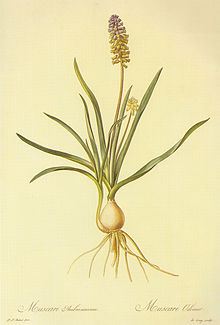Muscari racemosum
| Muscari racemosum | |
|---|---|

| |
| Scientific classification | |
| Kingdom: | Plantae |
| Clade: | Tracheophytes |
| Clade: | Angiosperms |
| Clade: | Monocots |
| Order: | Asparagales |
| Family: | Asparagaceae |
| Subfamily: | Scilloideae |
| Genus: | Muscari |
| Species: | M. racemosum
|
| Binomial name | |
| Muscari racemosum | |
| Synonyms[1] | |
| |
Muscari racemosum is a perennial bulbous flowering plant in the asparagus family Asparagaceae. The members of the genus are commonly known as grape hyacinths. Originally from south-west Turkey where it grows in rocky places, it is sometimes grown as an ornamental plant. It may be found in the horticultural literature under the synonym Muscari muscarimi.[2]
M. racemosum resembles M. macrocarpum (with which it has been placed in the Muscarimia group of the genus Muscari). It is a robust plant, with large bulbs which have thick fleshy roots. Each bulb produces several greyish-green leaves. Flowers are borne in a spike or raceme. Individual flowers are 7–9 mm long, grey-white when fully open, sometimes with a bluish tone; they have a distinct scent of musk.[2] This is the species from which the genus gets its name (Muscari is from the Greek muschos, meaning musk).[3]
References
- ^ WCSP (2011), World Checklist of Selected Plant Families, The Board of Trustees of the Royal Botanic Gardens, Kew, retrieved 2011-11-14, search for "Muscari racemosum"
- ^ ISBN 978-0-7134-4922-8, p. 130 (under the name M. muscarimi)
- JSTOR 1219056
